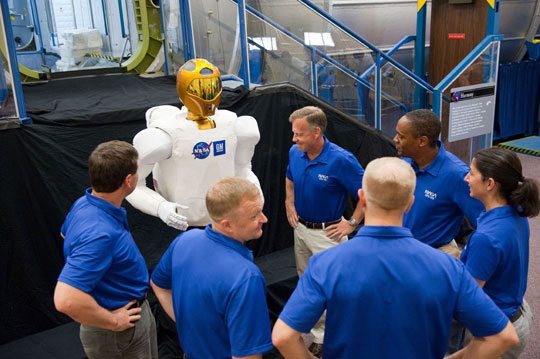Designed as an astronaut's assistant on a flight to the International Space Station, "robonaut" (robot astronaut) will be the number one choice for flights to the moon and Mars in the context of tight economy.
As planned, the space shuttle Discovery, carrying six American astronauts and one robonaut, was launched into orbit on November 5 last. However, after discovering four cracks that leaked hydrogen gas on the rocket's fuel tank, NASA (US Space Agency) decided to move the launch time to December 3. In the meantime, NASA engineers will overcome the consequences and ultimately resolve the technical problems of the missiles.

The six Discovery ship astronauts met R2 face. (Photo: NASA )
Smell "star wars"
The upcoming 39th flight of space shuttle Discovery, which has the STS-133 number, will be the final mission of the US space shuttle program. The program will officially end in 2011. NASA will set up another program to take astronauts to the planets by 2025.
After the shuttles (the program has five categories including: Columbia, Challenger, Discovery, Atlantis and Endeavor) retired, the US will hire Russia, Europe and Japan to take their astronauts to the International Space Station ( ISS). After that, the US commercial spacecraft will take care of this.
Despite a temporary error with ISS, robonaut has a very bright future. Robonaut was chosen to fly with Discovery as the second generation robot astronaut named R2 . This name is similar to R2-D2 , the famous robot in George Lucas' Star Wars series .
R2 is a collaborative product between the Dextrous Robotics Laboratory - a unit of NASA's Johnson Space Center, in Houston, Texas - and General Motors. Other specialized robots are designed to move large and heavy objects such as robotic arms, crane robots and terrain robots moving by wheels, robonaut shaped like a man carrying tasks that require skill smarter.
The first robonaut is designed to do maintenance tasks outside the ISS station space. They are designed by Robonaut R1A and R1B by NASA engineers and DARPA (an agency of the US Department of Defense specialized in developing new technologies) since 1997. But by 2006, due to lack of money, R1 project pause. General Motors jumped into production cooperation with the intention of perfecting the " mechanic robot " assembling cars. The first products of this collaboration are from 2002, in turn, the second generation R2 (including R2A and R2B).
R2 is the latest robonaut made of aluminum and nickel-plated carbon fiber worth $ 2.5 million. The R2 version currently has only the upper body, 1 m high, without legs, weighing 150 kg. It has two 0.6 m long arms that can move at 2 m / sec and a 20 cm long hand that can lift a dumbbell weighing 9 kg up and down easily. The hands of R2 are mounted with 350 sensors so it is possible to feel a very light object like bird feathers.
R2's brain is a central computer computer placed in the abdominal cavity. Its eyes include 4 cameras placed in the top of the yellow paint head and an infrared camera in the mouth. Electrical system placed behind the back.

R2 knows how to call mobile phones .
In the immediate future, only the assistant
Once posted to ISS, R2 will be mounted on a fixed base and undergone a series of tests to see how it is adapted to zero gravity. With R2, NASA has no ambition to make it completely replace astronauts. They just want it to help astronauts complete maintenance and cleaning tasks, holding repair tools when the astronaut steps out into space to repair.
In the next phase, people will put their feet in R2 so that it moves in the corridor of the ISS. At that time, robonaut would have stepped out into space without fear of radioactivity or the terrible cold price for humans to perform the repair of equipment located outside the ISS. It will also be used in emergency situations such as fire fighting or handling toxic gas leaks.
According to the plan, R2's trip is " going without it ". At the end of 2011, NASA will send a pair of legs to assemble into R2 for it to practice. In 2012, NASA will replace R2's body with a new, improved body. At that time, R2 can walk and walk in space.
At the final stage, a new R2 version is fitted with 4 wheels to explore the moon and Mars. A similar robonaut called Centaur 2 has been tested on Arizona desert.
Commenting on R2, doctor-astronaut Michael Barratt - one of six astronauts on board Discovery - said that the R2 model now takes a lot of time to complete to become an effective aide of astronauts. family. Like astronauts, R2 needs a lot of practice.
Barratt said he was most happy that he would not have to sweep the house (the ISS station) because R2 had done it. He could not speak and was completely obedient, so he was very comfortable working with it. The biggest advantage of robonaut is that it can get into a toxic gas to lock the valve or turn it on - turn off the switch.
According to NASA, R2's immediate goal is to help but not replace astronauts.
Watch the introduction video for R2
 Van Allen's belt and evidence that the Apollo 11 mission to the Moon was myth
Van Allen's belt and evidence that the Apollo 11 mission to the Moon was myth The levels of civilization in the universe (Kardashev scale)
The levels of civilization in the universe (Kardashev scale) Today Mars, the sun and the Earth are aligned
Today Mars, the sun and the Earth are aligned The Amazon owner announced a secret plan to build a space base for thousands of people
The Amazon owner announced a secret plan to build a space base for thousands of people